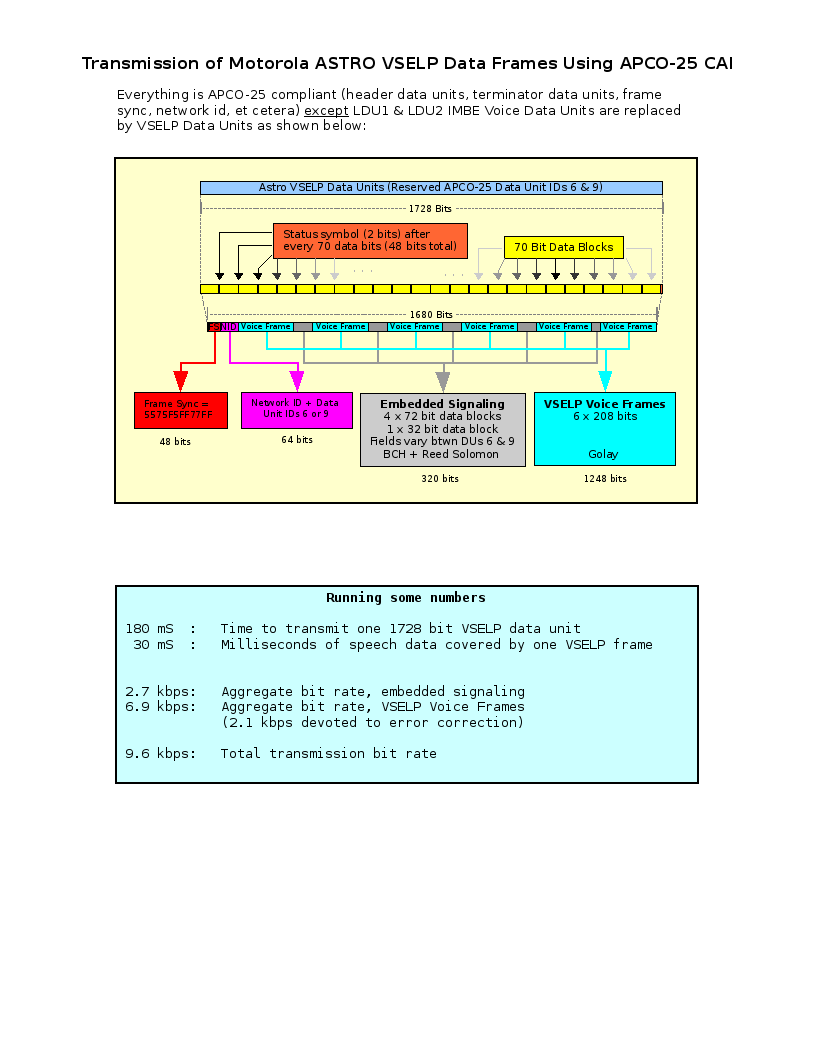

Let
us number the 208 received bits of a VSELP frame in order as they are
received from zero to 207. If we then place these bits into a table
sized to match the apparent interleave pattern, and highlight some
related bits we end up with something like the following:
|
0 |
1 |
2 |
3 |
4 |
5 |
6 |
7 |
8 |
9 |
10 |
11 |
12 |
13 |
14 |
15 |
16 |
17 |
18 |
19 |
20 |
21 |
22 |
23 |
|
24 |
25 |
26 |
27 |
28 |
29 |
30 |
31 |
32 |
33 |
34 |
35 |
36 |
37 |
38 |
39 |
40 |
41 |
42 |
43 |
44 |
45 |
46 |
47 |
|
48 |
49 |
50 |
51 |
52 |
53 |
54 |
55 |
56 |
57 |
58 |
59 |
60 |
61 |
62 |
63 |
64 |
65 |
66 |
67 |
68 |
69 |
70 |
71 |
|
72 |
73 |
74 |
75 |
76 |
77 |
78 |
79 |
80 |
81 |
82 |
83 |
84 |
85 |
86 |
87 |
88 |
89 |
90 |
91 |
92 |
93 |
94 |
95 |
|
96 |
97 |
98 |
99 |
100 |
101 |
102 |
103 |
104 |
105 |
106 |
107 |
108 |
109 |
110 |
111 |
112 |
113 |
114 |
115 |
116 |
117 |
118 |
119 |
|
120 |
121 |
122 |
123 |
124 |
125 |
126 |
127 |
128 |
129 |
130 |
131 |
132 |
133 |
134 |
135 |
136 |
137 |
138 |
139 |
140 |
141 |
142 |
143 |
|
144 |
145 |
146 |
147 |
148 |
149 |
150 |
151 |
152 |
153 |
154 |
155 |
156 |
157 |
158 |
159 |
160 |
161 |
162 |
163 |
164 |
165 |
166 |
167 |
|
168 |
169 |
170 |
171 |
172 |
173 |
174 |
175 |
176 |
177 |
178 |
179 |
180 |
181 |
182 |
183 |
184 |
185 |
186 |
187 |
188 |
189 |
190 |
191 |
|
192 |
193 |
194 |
195 |
196 |
197 |
198 |
199 |
200 |
201 |
202 |
203 |
204 |
205 |
206 |
207 |
|
|
|
|
|
|
|
|
Color
key:
|
Color |
Bits |
Comments |
|
|
17 |
Block Code (Hamming Distance 7) |
|
|
17 |
Block Code (Hamming Distance 7) |
|
|
23 |
GOLAY (23,12,7) |
|
|
23 |
GOLAY (23,12,7) |
|
|
23 |
GOLAY (23,12,7) |
|
|
8 |
Speculative grouping |
|
|
3 |
Always Zero |
Comments:
We
note that even indices naturally have better error protection as a
result of 4-Level FSK modulation. And indeed, those bits that have
error protection coding tend to fall on even indices. There is
obviously still a long way to go on the analysis.
The information in this section is subject to
change. The identification and location of the three Golay
(23,13) data blocks are almost certainly correct. The 17 bit
blocks shown in green and violet are definitely related - treated as 17
bit data words they exhibit a 7 bit minimum Hamming distance sufficient
to correct any three bit errors; it might however be premature to chalk
this up to something like a (17,8,7) or similar block code. More
work may turn up further correlated bit groups such as that speculative
8 bit grouping.
While there is some possibility that this work by itself could lead to an decoder that produces intelligible ASTRO VSELP speech it is far more likely that VSELP test frames will have to be constructed and fed into surplus radio equipment in order to back out bit functions, voice code tables, et cetera. This is the impetus for for characterizing the error correcting coding. Getting surplus radio equipment is not a problem since this mode is technically obsolete and most everyone is migrating to fully APCO-25 compliant systems (although *certain* legacy governmental ASTRO VSELP systems will likely remain in use for years to come).
| AstroTurf is a registered trademark of AstroTurf LLC. Astro is the Jetson's dog. Astro also happens to be a registered trademark of Motorola, Inc. |